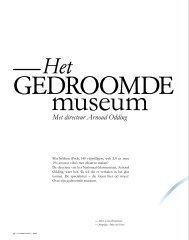Dichter op de Huid - O dubbel d
Dichter op de Huid - O dubbel d
Dichter op de Huid - O dubbel d
You also want an ePaper? Increase the reach of your titles
YUMPU automatically turns print PDFs into web optimized ePapers that Google loves.
Lucy Orta<br />
Totipotent Architecture<br />
> pagina VI<br />
Keiko Sato<br />
Installation<br />
> pagina II<br />
OVER / OP / IN / VOORBIJ DE HUID<br />
Kunstenaars<br />
Lucy Orta, doceert Kunst, Mo<strong>de</strong> en Vormgeving<br />
aan het Lon<strong>de</strong>n College of Fashion.<br />
Ze is geboren in Engeland maar werkt en<br />
woont sinds 1991 in Parijs. Zij begon haar<br />
carrière met het ontwerpen van “Body<br />
Architecture”, beel<strong>de</strong>n als draagbare<br />
architectuur: tenten of slaapzakken<br />
veran <strong>de</strong>ren in beschermen<strong>de</strong> kleding.<br />
Haar huidige on<strong>de</strong>rzoek richt zich <strong>op</strong><br />
<strong>de</strong> <strong>op</strong>enbare ruimte en met haar man<br />
Jorge Orta ontwikkelt ze grootschalige<br />
architectonische kunst. Voor <strong>Dichter</strong> <strong>op</strong><br />
<strong>de</strong> huid heeft Orta in Leerdam organische<br />
glazen vormen laten maken. De vormen<br />
zijn gebaseerd <strong>op</strong> haar on<strong>de</strong>rzoek naar<br />
het differentiatieproces dat lichaamscellen<br />
on<strong>de</strong>rgaan bij het vormen van <strong>de</strong> archi–<br />
tec tuur van ons lichaam. In dunne stalen<br />
frames vormt het glas maquettes van<br />
historische gebouwen. Het zijn abstracte<br />
voorstellen voor <strong>de</strong> transformatie van<br />
verlaten locaties. De architectuur wordt<br />
nieuw leven ingeblazen en <strong>de</strong> bestaan<strong>de</strong><br />
structuren van het gebouw gaan een dialoog<br />
aan met <strong>de</strong> vloeibaarheid van het glas.<br />
Lucy Orta, Professor of Art,<br />
Fashion and the Environment at<br />
London College of Fashion was<br />
born in England but resi<strong>de</strong>s in<br />
Paris since 1991. She began her<br />
artistic career by creating ‘Body<br />
Architecture’, sculptures that<br />
resemble portable architecture:<br />
tents or sleeping bags that<br />
covert into protective clothing.<br />
Her current research focuses<br />
on public-space and with<br />
her husband Jorge Orta they<br />
<strong>de</strong>vel<strong>op</strong> large-scale architectural<br />
artworks. For Skin Deep, Orta<br />
created organic glass forms in<br />
Leerdam based on her research<br />
with cell-biologists, interpreting<br />
the process of differentiation<br />
cells un<strong>de</strong>rgo to create the<br />
actual architecture of our body.<br />
They are integrated into fine<br />
steel maquettes of historical<br />
buildings to create a series<br />
of abstract pr<strong>op</strong>osals for the<br />
transformation of abandoned<br />
locations - breathing new life<br />
into architecture where the<br />
formal structure of the building<br />
dialogues with the fluidity of glass.<br />
Aan <strong>de</strong> installaties van Keiko Sato (Japan 1957) ligt <strong>de</strong> verbinding<br />
van een Westers en Aziatisch <strong>de</strong>nken ten grondslag. De centrale<br />
rol van het individu in het westen wordt in haar werk versmolten<br />
met Aziatische gemeenschapszin. De installaties zijn vaak <strong>op</strong>gezet<br />
als landschappen die een relatie met <strong>de</strong> structuur en geschie<strong>de</strong>nis<br />
van die specifieke plek aangaan. In Fort Asperen toont zij een<br />
project waarbij het zand <strong>de</strong> huid verbeeldt met gebroken glas<br />
als symbool voor fysieke en geestelijke pijn. De flessen zijn <strong>op</strong><br />
speciale manieren gebroken, door hitte, bevriezing en kracht.<br />
Tij<strong>de</strong>ns het maken van <strong>de</strong> installatie vervalt <strong>de</strong> functie van fles en<br />
veran<strong>de</strong>rt ze in iets onbekends. De installatie en het bijbehoren<strong>de</strong><br />
geluid door Makiko Sadakata versmelten in een wereld ‘voorbij<br />
<strong>de</strong> huid’.<br />
The basis for the installations by Keiko Sato (Japan, 1957) have<br />
<strong>de</strong>vel<strong>op</strong>ed from her experience and thought in Eur<strong>op</strong>e. The<br />
role of individualism in the West is conceptualized in her work<br />
as a fusion with Asiatic collectiveness. The installations are often<br />
constructed as landscape with regards to the structure and the<br />
history of the space. In the installations, especially ma<strong>de</strong> for<br />
Fort Asperen, she shows that sand forms like skin with broken<br />
glass symbolizing physical and mental pain. The glass bottles<br />
are broken by heat, cooling and force. In the process of making<br />
the installation, their function as a container disappears and<br />
transforms into something unknown. The sound, by Makiko<br />
Sadakata and the installation integrate and create a world<br />
“Beyond the skin.”<br />
About / ON / IN / Un<strong>de</strong>r thE skin<br />
Artists<br />
64 Nationaal Glasmuseum Leerdam / Fort Asperen<br />
Skin Deep / <strong>Dichter</strong> <strong>op</strong> <strong>de</strong> huid<br />
65



